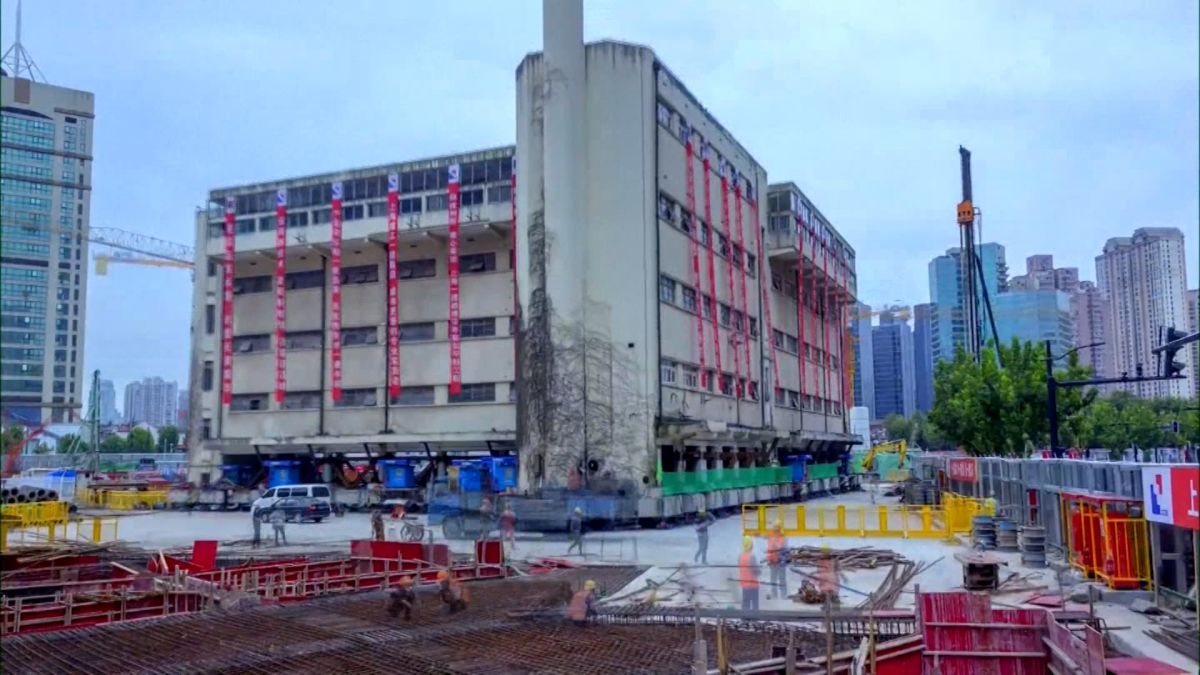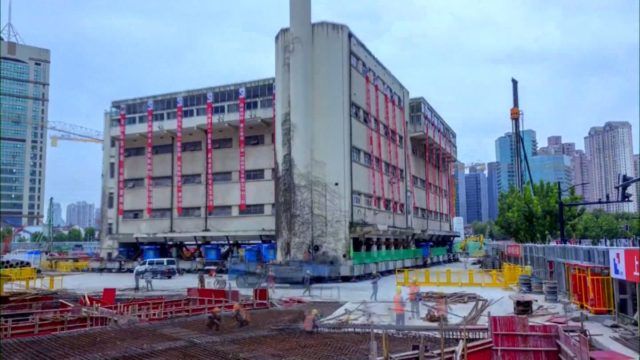
A huge surprise greeted Shanghai residents who, passing through the city’s eastern Huangpu district stumbled upon an unusual sight: a “walking” building.
An 85-year-old primary school has been lifted off the ground — in its entirety — and relocated using new technology dubbed the “walking machine.”
This was an initiative born out of the city’s effort to preserve historic structures; engineers attached nearly 200 mobile supports under the five-story building, according to Lan Wuji, chief technical supervisor of the project.
The supports act like robotic legs. They’re split into two groups which alternately rise up and down, imitating the human stride. Attached sensors help control how the building moves forward, said Lan, whose company Shanghai Evolution Shift developed the new technology in 2018.
“It’s like giving the building crutches so it can stand up and then walk,” he said.
According to a statement from the Huangpu district government, the Lagena Primary School was constructed in 1935 by the municipal board of Shanghai’s former French Concession. It was moved in order to make space for a new commercial and office complex, which will be completed by 2023.
Workers had to first dig around the building to install the 198 mobile supports in the spaces underneath, Lan explained. After the pillars of the building were truncated, the robotic “legs” were then extended upward, lifting the building before moving forward.
Over the course of 18 days, the building was rotated 21 degrees and moved 62 meters (203 feet) away to its new location. The relocation was completed on October 15, with the old school building set to become a center for heritage protection and cultural education.
The project marks the first time this “walking machine” method has been used in Shanghai to relocate a historical building, the government statement said.
In recent decades, China‘s rapid modernization has seen many historic buildings razed to clear land for gleaming skyscrapers and office buildings. But there has been growing concern about the architectural heritage lost as a result of demolition across the country.
Some cities have launched new preservation and conservation campaigns including, on occasion, the use of advanced technologies that allow old buildings to be relocated rather than demolished
nonetheless, relentless urbanization has continued to pose a significant threat to architectural heritage. The sale of land is also a key source of revenue for local governments, meaning that buildings with architectural value are often sold off to property developers for whom conservation is not a priority.
In the capital Beijing, for instance, more than 1,000 acres of its historic alleys and traditional courtyard homes were destroyed between 1990 and 2010, according to state-run newspaper China Daily
In the early 2000s, cities including Nanjing and Beijing — prompted by critics protesting the loss of old neighborhoods — drew up long-term plans to preserve what was left of their historic sites, with protections introduced to safeguard buildings and restrict developers.
These conservation efforts have taken different forms. In Beijing, a near-ruined temple was transformed into a restaurant and gallery, while in Nanjing, a cinema from the 1930s was restored to resemble its original form, with some additions outfitting it for modern use. In 2019, Shanghai welcomed Tank Shanghai, an arts center built in renovated oil tanks.
“Relocation is not the first choice, but better than demolition,” said Lan, the Shanghai primary school’s project supervisor. “I’d rather not touch the historical buildings at all. Building relocations he said however are “a viable option.”
Shanghai has arguably been China’s most progressive city when it comes to heritage preservation. The survival of a number of 1930s buildings in the famous Bund district and 19th-century “shikumen” (or “stone gate”) houses in the renovated Xintiandi neighborhood have offered examples of how to give old buildings new life, despite some criticism about how the redevelopments were carried out.
The city also has a track record of relocating old buildings. In 2003, the Shanghai Concert Hall, built in 1930, was moved over 66 meters (217 feet) to make way for an elevated highway. The Zhengguanghe Building — a six-story warehouse, also from the 1930s — was then shifted 125 feet (38 meters) as part of a local redevelopment in 2013.
More recently, in 2018, the city relocated a 90-year-old building in Hongkou district, in what was then considered to be Shanghai’s most complex relocation project to date, according to state-run news agency Xinhua.
There are a few ways to go about moving a building: It can slide down a set of rails, or be pulled along by vehicles, for instance.
But the Lagena Primary School, which weighs 7,600 tons, posed a new challenge — it’s T-shaped, whereas previously relocated structures were square or rectangular, according to Xinhua. The irregular shape meant that traditional methods of pulling or sliding may not have worked because it may not have withstood the lateral forces placed on it, said Lan.
Experts and technicians met to discuss possibilities and test a number of different technologies before deciding on the “walking machine,” Xinhua said.
While many Architects and structural engineers would try to speculate on the huge cost this process could incure it is safe to say according to Xinhua that “it’s cheaper than demolishing and then rebuilding something in a new location.”
Gift Joseph Okpakorese
Staff Writer







